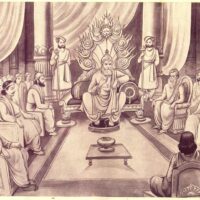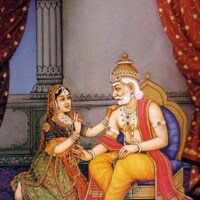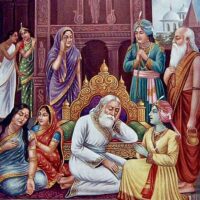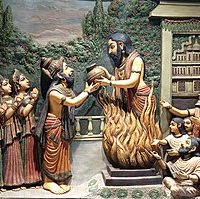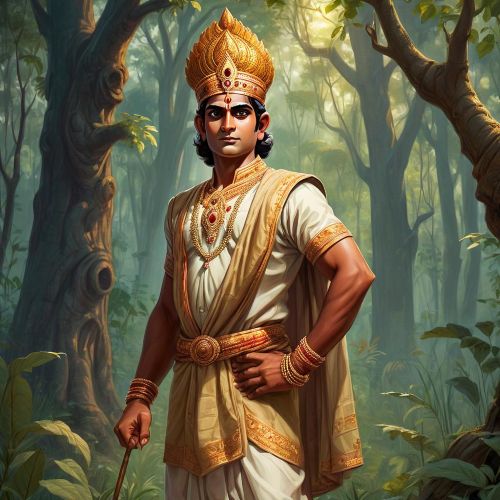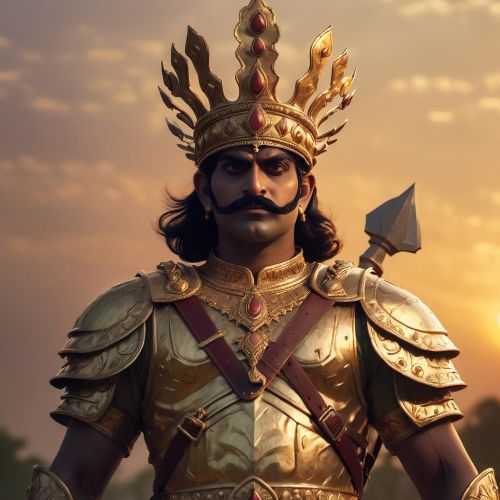Dasharatha : The Warrior King
Listen
At a glance
| Description | |
|---|---|
| Origin | Indian Mythology |
| Classification | Mortals |
| Family Members | Kausalya, Sumitra, Kaikeyi (Wives), Rama, Bharata, Lakshmana, Shatrughna (Sons) |
| Region | India |
| Associated With | Royalty, Leadership |
Dasharatha
Introduction
Dasharatha, the legendary king of Ayodhya, holds a revered place in Indian mythology as a central figure in the Ramayana. He is best remembered as the father of Rama, the seventh incarnation of Vishnu, and as a ruler whose life was deeply intertwined with the ideals of dharma, sacrifice, and destiny. His reign in the kingdom of Kosala is described as a time of prosperity and justice, yet his personal life was marked by profound trials and sorrow. Dasharatha’s story is not merely about royal grandeur but about the human struggles of duty, promises, and paternal love that transcend centuries.
Physical Traits
Dasharatha belonged to the illustrious Ikshvaku dynasty, tracing his ancestry back to the solar lineage of Manu, the progenitor of mankind. His father was King Aja, and his mother was Indumati, who came from a noble lineage herself. His queens played crucial roles in shaping his legacy: Kausalya, his chief consort, gave birth to Rama; Kaikeyi, his favorite wife, bore Bharata; and Sumitra, renowned for her wisdom, became the mother of the twins Lakshmana and Shatrughna. Together, these four princes would grow up to embody values of loyalty, sacrifice, and brotherhood, each fulfilling a significant role in the Ramayana. Dasharatha’s affection for his children, particularly Rama, reveals his human vulnerability, and his eventual demise is linked directly to his grief over separation from his beloved son.
Family
Dasharatha belonged to the illustrious Ikshvaku dynasty, tracing his ancestry back to the solar lineage of Manu, the progenitor of mankind. His father was King Aja, and his mother was Indumati, who came from a noble lineage herself. His queens played crucial roles in shaping his legacy: Kausalya, his chief consort, gave birth to Rama; Kaikeyi, his favorite wife, bore Bharata; and Sumitra, renowned for her wisdom, became the mother of the twins Lakshmana and Shatrughna. Together, these four princes would grow up to embody values of loyalty, sacrifice, and brotherhood, each fulfilling a significant role in the Ramayana. Dasharatha’s affection for his children, particularly Rama, reveals his human vulnerability, and his eventual demise is linked directly to his grief over separation from his beloved son.
Other names
Throughout history, Dasharatha has been referred to by different names that emphasize his valor and stature. One of his epithets is Nemi, highlighting his martial skills. The most widely known name, Dasharatha or Dasarath, translates as “one who can ride in ten chariots” or “the warrior capable of controlling ten directions,” a reference to his unparalleled command over chariots in warfare. Ancient tales also recall that the gods themselves recognized his bravery during battles against demonic forces, bestowing upon him this distinguished title. These names not only underline his martial accomplishments but also situate him as a king whose prowess was celebrated both on earth and in the divine realm.
Powers and Abilities
Dasharatha’s reputation as a warrior king rests largely on his exceptional command over chariots and his strategic genius in battle. His ability to fight as though supported by ten charioteers at once made him a formidable presence on the battlefield. Stories also describe his unique hunting skill—he could shoot arrows guided solely by sound, an ability that, though extraordinary, also became the source of a tragic incident when he accidentally killed Shravan Kumar, setting into motion the curse that would later haunt him. Beyond his martial skills, Dasharatha was also deeply learned in Vedic rituals. It was through the sacred Putrakameshti Yajna, a ritual performed under sage Rishyasringa’s guidance, that he was blessed with his four sons. His life reveals a balance between physical valor and spiritual discipline, making him an archetypal king in Hindu tradition.
Modern Day Influence
The legacy of Dasharatha has continued to echo through centuries, shaping cultural narratives across South and Southeast Asia. His life story is retold in the Valmiki Ramayana and its countless regional versions, such as Tulsidas’ Ramcharitmanas in Awadhi and Kamban’s Kamba Ramayanam in Tamil. These adaptations preserve his character as a ruler whose personal sacrifices highlight the moral dilemmas faced by those in positions of power. Dasharatha’s grief at sending Rama into exile remains one of the most poignant portrayals of parental love in world literature.
In the arts, his story has been immortalized in miniature paintings, temple carvings, and Pahari art, where scenes of his anguish are depicted with emotional intensity. In popular culture, television adaptations like Ramanand Sagar’s Ramayan brought Dasharatha’s character into modern homes, making him a recognizable figure for contemporary audiences. Films and plays inspired by the Ramayana continue to portray his role as a symbol of sacrifice, reminding viewers of the cost of upholding dharma.
His influence is also evident in Buddhist literature, particularly the Dasaratha Jataka, where parallels are drawn between his story and the Buddha’s teachings. This demonstrates how his character transcended Hindu mythology, resonating with broader spiritual traditions across Asia. Today, Dasharatha is often studied as an example of leadership balanced by human vulnerability, a reminder that even the greatest kings are bound by the laws of fate and moral duty.
Related Images
Source
Bhattacharji, S. (1987). Sukumari Bhattacharji, Literature in the Vedic Age; Vol. I. The Saṃhitas, Baġchi Indological Series 3, Calcuta, Bagchi & Company, 1984, pp. XXXII + 335. Orientalistische Literaturzeitung, 82(1), 54–55.
Das, A. (2018, February 28). The sons of Dasaratha. The Mythology Project. https://themythologyproject.com/the-sons-of-dasaratha/
Goodreads. (n.d.). Dasharatha: The Story of Rama’s Father. Retrieved August 19, 2025, from https://www.goodreads.com/book/show/34828036-dasharatha
Indianetzone. (n.d.). Dasaratha. Retrieved August 19, 2025, from https://www.indianetzone.com/dasaratha
Jaiswal, P. (2020). Asura: Myths and Modern Representations in India. (Master’s thesis). Thammasat University.
KidsGen. (n.d.). King Dasaratha’s Tragic Fate and the Pain of Separation. Retrieved August 19, 2025, from https://www.kidsgen.com/fables_and_fairytales/indian_mythology_stories/the_curse.htm
Kishore, C. (2014, April 14). RAMAYANA: CHAPTER 1: DASARATHA’S DESIRE FOR A CHILD. Indian Myth. https://indianmyth.wordpress.com/2014/04/14/ramayana-chapter-1-dasarathas-desire-for-a-child/
Mahavidya. (2016, April 26). King Dasaratha. Mahavidya.ca. https://mahavidya.ca/2016/04/26/king-dasaratha/
Pattnaik, D. (2021). Retelling Indian Mythology Through The Novels Of Devdutt Pattnaik. Annals of the Romanian Society for Cell Biology, 25(6), 11452–11459.
Sivasubramanian, S. (2017, December 12). For what reason did Dasharatha marry three women? Hinduism Stack Exchange. https://hinduism.stackexchange.com/questions/22699/for-what-reason-did-dasharatha-marry-three-women
Vedapurana. (n.d.). Meaning of “Dasaratha” – VedaPurana | Hindu Encyclopedia. Retrieved August 19, 2025, from https://vedapurana.org/single.php?s=1368&word=Dasaratha&secure
Wikipedia. (n.d.). Dasharatha – Wikipedia. Retrieved August 19, 2025, from https://en.wikipedia.org/wiki/Dasharatha
Wisdom Library. (2019, January 28). Story of Daśaratha. Wisdomlib.org. https://www.wisdomlib.org/hinduism/compilation/puranic-encyclopaedia/d/doc241522.html
Frequently Asked Questions
What is lorem Ipsum?
I am text block. Click edit button to change this text. Lorem ipsum dolor sit amet, consectetur adipiscing elit. Ut elit tellus, luctus nec ullamcorper mattis, pulvinar dapibus leo.
What is lorem Ipsum?
I am text block. Click edit button to change this text. Lorem ipsum dolor sit amet, consectetur adipiscing elit. Ut elit tellus, luctus nec ullamcorper mattis, pulvinar dapibus leo.
What is lorem Ipsum?
I am text block. Click edit button to change this text. Lorem ipsum dolor sit amet, consectetur adipiscing elit. Ut elit tellus, luctus nec ullamcorper mattis, pulvinar dapibus leo.
What is lorem Ipsum?
I am text block. Click edit button to change this text. Lorem ipsum dolor sit amet, consectetur adipiscing elit. Ut elit tellus, luctus nec ullamcorper mattis, pulvinar dapibus leo.
What is lorem Ipsum?
I am text block. Click edit button to change this text. Lorem ipsum dolor sit amet, consectetur adipiscing elit. Ut elit tellus, luctus nec ullamcorper mattis, pulvinar dapibus leo.


